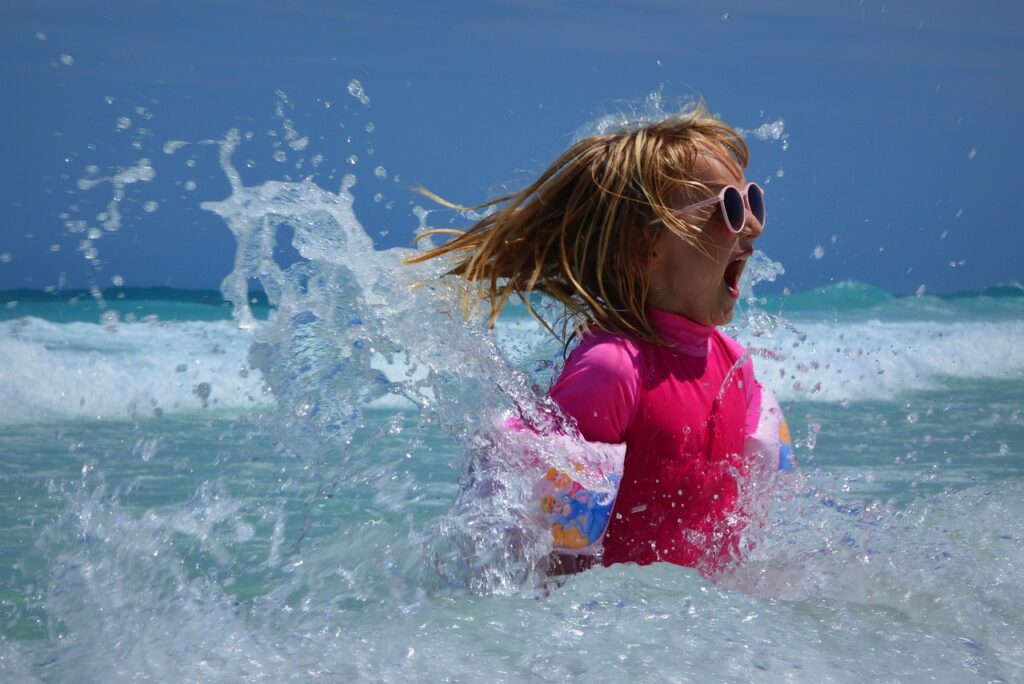Summer is the perfect time to cool off and enjoy some fun in the sun, and swimming in the sea is an excellent way to do so. However, for those who are not confident in the water or who have never learned to swim, the sea can be intimidating. In this blog post, we will explore techniques for learning to swim and provide tips for teaching your child to swim in the sea.
Learning Basic Techniques for Teaching Your Child to Swim
Once comfortable in the water, it is time to start learning basic swimming techniques such as floating, kicking, and stroke movements. Practice and repetition are key to mastering these skills.
Floating, kicking, and stroke movements are three essential techniques used in swimming to achieve efficient and effective movement through the water.
1. Floating
Floating is a technique that enables a swimmer to stay on the water’s surface without sinking. To flow, the swimmer must relax, take a deep breath, and lay back with extended arms and legs. As a parent, you should tilt your child’s head back, and the face should be in the water, allowing the swimmer to breathe comfortably. Keeping the body as still as possible and maintaining a relaxed posture is essential. A swimmer can achieve a comfortable and sustainable float by adjusting their breath and body position.
2. Kicking
Kicking is a technique that involves the movement of the legs to propel the body forward. Two main types of kicks are used in swimming: the flutter kick and the dolphin kick. The flutter kick involves alternating quick movements of the legs up and down, generating forward momentum. The dolphin kick is a more advanced kick technique that consists of the swimmer using both legs in a wave-like motion to generate power and speed. To perform a lift, the swimmer must keep their legs straight and move them fluidly. Kicking provides the swimmer with the ability to move through the water efficiently.
3. Stroke Movements
Stroke movements are techniques to move the arms through the water to generate forward momentum. The four main stroke movements used in swimming are the freestyle stroke (also known as the front crawl), the backstroke, the breaststroke, and the butterfly stroke.
The freestyle stroke involves the swimmer alternating their arms in a circular motion, propelling the body forward. The backstroke involves a similar movement but is performed while lying on the back.
The breaststroke involves a frog-like kick and a scooping motion of the arms.
In contrast, the butterfly stroke involves a dolphin-like undulation of the body and the arms moving in unison. The stroke movements generate speed and momentum and maintain a steady pace during a swim.
9 Tips for Teaching Your Child to Swim
If you’re a parent looking for ways to teach your child to swim, don’t worry! With the proper Techniques for Teaching a Child to Swim, it can be a fun and rewarding experience for both of you. And remember, safety is vital, so prioritize it and continue learning to improve and enjoy the benefits of swimming.
1. Overcoming Fear of Water
The first step in learning to swim is overcoming a fear of water. This can be achieved by gradually acclimating oneself to the water, starting with simple activities such as wading and splashing in shallow water.
2. Practicing in a Pool
Before attempting to swim in the sea, it is advisable to practice in a pool. Pools provide a controlled environment where one can practice swimming techniques and build up strength and stamina.
3. Choosing the Right Beach
When teaching your child to swim in the sea, it is important to choose the right beach. Look for beaches with shallow, calm waters and a gentle slope, where your child can gradually acclimate to the water and practice swimming techniques.
4. Safety First
Always prioritize safety when swimming in the sea. Make sure to supervise children at all times. Additionally, make sure to check for any currents, rip tides, or other potential hazards before entering the water.
5. Using Floatation
Devices For those who are still building up their swimming skills, floatation devices such as life jackets or arm floats can provide an added sense of security and confidence in the water.
6. Starting Small
When teaching your child to swim in the sea, start small and gradually build up to more challenging activities. Start by simply splashing around in shallow water and gradually move on to swimming further out and practicing more advanced techniques.
7. Games and Activities
To make learning to swim more fun and engaging, incorporate games and activities into the process. Try playing games such as “Marco Polo” or “Red Light, Green Light” to encourage your child to swim and practice their skills.
Read more: 7 GAMES FOR KIDS TO TEACH SWIMMING IN THE SEA
8. Positive Reinforcement
Offer plenty of positive reinforcement and encouragement when teaching your child to swim. Celebrate each small victory and encourage them to keep practicing and improving their skills.
9. Continuing Education
Learning to swim is a lifelong process, and it is important to continue practicing and building upon one’s skills. Consider enrolling in a swim class or joining a swim club to continue improving and enjoying the benefits of swimming.
In conclusion, learning to swim and teaching your child to swim in the sea can be an enjoyable and rewarding experience. By following these techniques and tips, you can build up your swimming skills and confidence in the water, and create fun memories for years to come.




